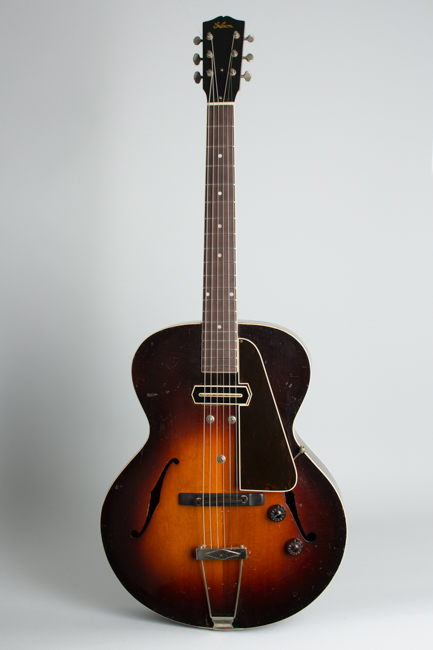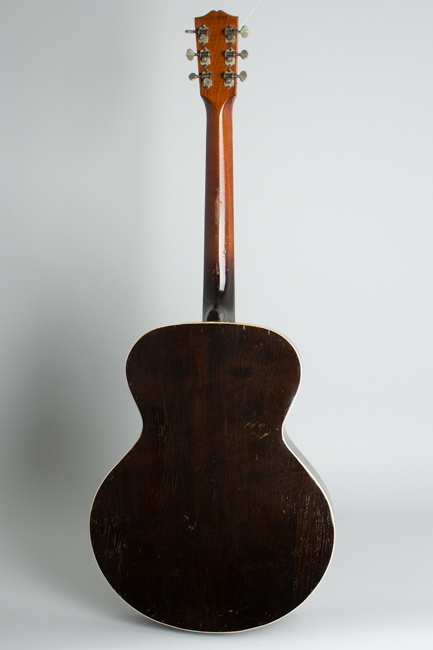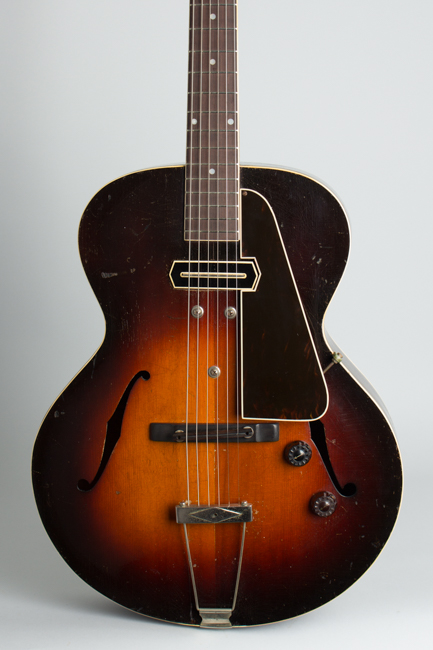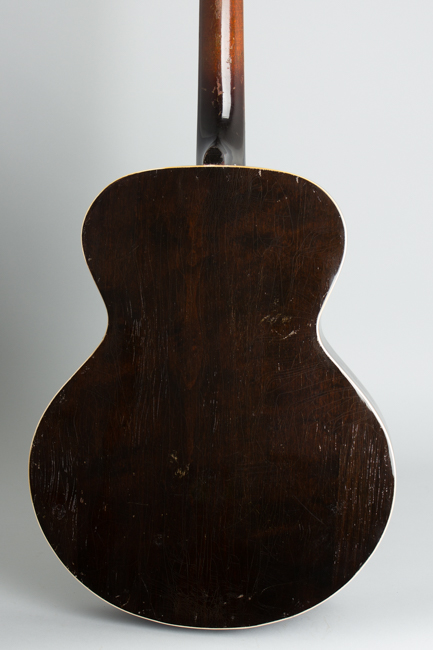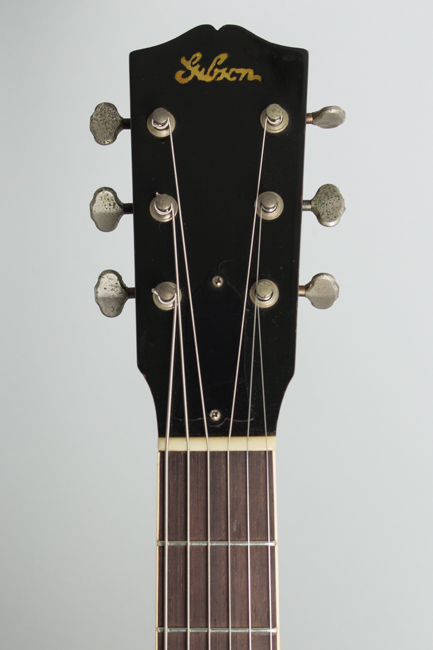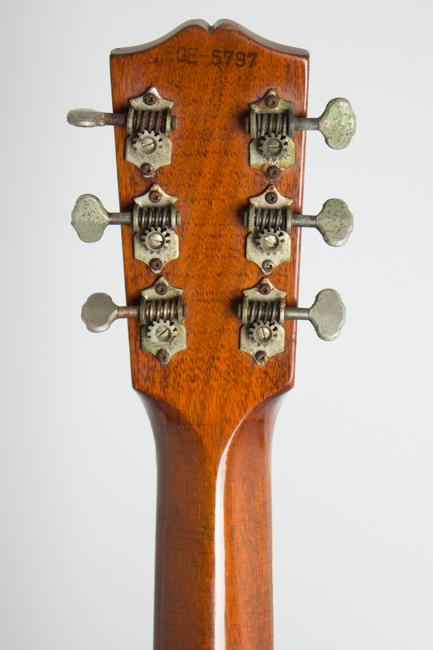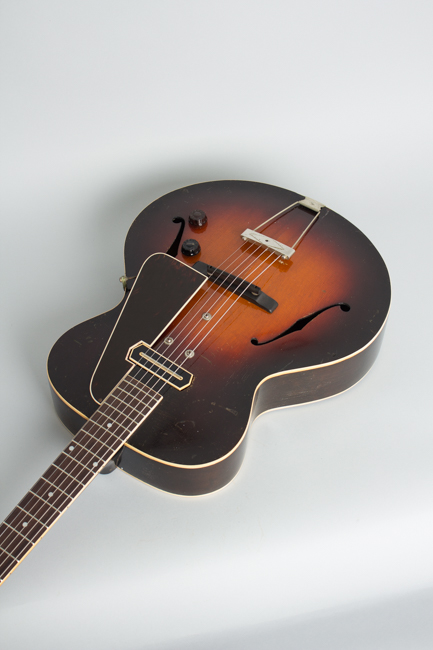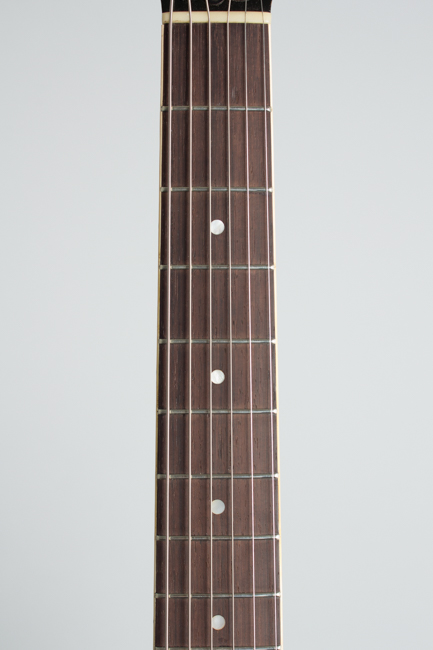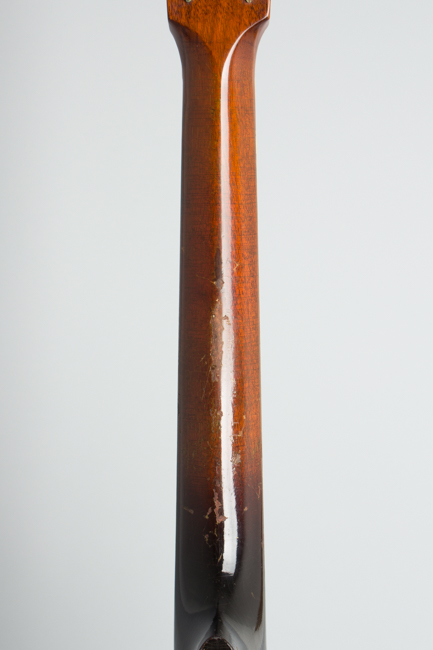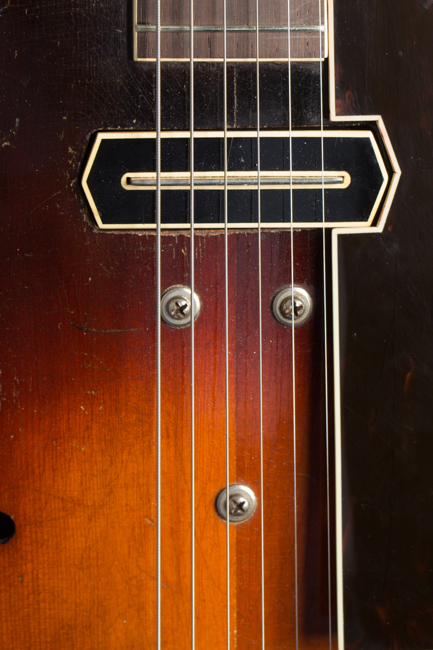Gibson ES-150 Arch Top Hollow Body Electric Guitar (1939)
This item has been sold.
Item # 8589
Prices subject to change without notice.
Gibson ES-150 Model Arch Top Hollow Body Electric Guitar (1939), made in Kalamazoo, Michigan, serial # EGE-5797, sunburst top, dark back and sides finish, maple back and sides, spruce top; mahogany neck with rosewood fingerboard, original tweed hard shell case.
The early Gibson ES-150 is quite simply one of the most important electric guitars of all time, and beyond that still an exceptionally fine player's instrument 80 years on. Most often associated with Charlie Christian, this model was the first truly commercially successful electric Spanish guitar and the progenitor of the entire Gibson electric line. While many early electrics from the 1930s have a rather mongrel look, the 150 has a beautifully understated elegance that undoubtedly helped it gain acceptance on the formal bandstands of the time. It was a well-regarded and relatively popular instrument when new, but the 1930s market for electric Spanish guitars was quite small.
This particular guitar is a 1939 model still with the first "Spanish" version of the famous bar magnet pickup featuring a single-bound top edge and a straight un-notched blade under the strings. The tuners are typical Grover G-97s, which were changed to early model Klusons later this year. The dark sunburst top is single-bound, the back and sides finished in a dark chocolate brown, and a pearl Gibson logo adorns the headstock.
Only 232 examples of this seminal instrument were shipped out of Kalamazoo in 1939 -- the electric guitar was still very much a minority taste at the time! This guitar has had some serious play time the past but remains a great-sounding, fine-playing example of this rare and much sought-after instrument.
Overall length is 40 1/4 in. (102.2 cm.), 16 1/16 in. (40.8 cm.) wide at lower bout, and 3 5/8 in. (9.2 cm.) in depth, measured at side of rim. Scale length is 24 3/4 in. (629 mm.). Width of nut is 1 3/4 in. (44 mm.).
This guitar has been well-played through the decades but remains an excellent instrument. There is less finish wear overall than many surviving examples of this model; often the top lacquer is heavily worn through near the fingerboard from pick action, which is not the case here. Overall the finish does show a decent amount of wear with scrapes and dings and some moderately heavy checking. There are a couple of rather deep dings into the top wood near the bass side waist area. There is some wear through to the wood on the back of the neck, mostly between the fourth and eighth frets. The top shows a neatly repaired spruce grain crack near the bass side of the tailpiece.
The hardware is original except the tortoise celluloid pickguard is a nicely done repro (the bracket is original) as is the period-style bridge (which has the original posts and wheels). The all-important Charlie Christian pickup is original; the pots and jack have been replaced, but the originals are included. The period 2-color knobs (one brown, one black) with delicate arrows engraved in the tops are still mounted. There is a small hole drilled on the middle of the tailpiece bar, for reasons lost to history. The original tuners show some corrosion but still function well.
The fingerboard has been trued and refretted with period correct style wire and the guitar is an excellent player. Overall this is a great player's example of this most historic instrument with the expected fantastic sound, housed in a well-worn but functional original tweed HSC. Very Good + Condition.
The early Gibson ES-150 is quite simply one of the most important electric guitars of all time, and beyond that still an exceptionally fine player's instrument 80 years on. Most often associated with Charlie Christian, this model was the first truly commercially successful electric Spanish guitar and the progenitor of the entire Gibson electric line. While many early electrics from the 1930s have a rather mongrel look, the 150 has a beautifully understated elegance that undoubtedly helped it gain acceptance on the formal bandstands of the time. It was a well-regarded and relatively popular instrument when new, but the 1930s market for electric Spanish guitars was quite small.
This particular guitar is a 1939 model still with the first "Spanish" version of the famous bar magnet pickup featuring a single-bound top edge and a straight un-notched blade under the strings. The tuners are typical Grover G-97s, which were changed to early model Klusons later this year. The dark sunburst top is single-bound, the back and sides finished in a dark chocolate brown, and a pearl Gibson logo adorns the headstock.
Only 232 examples of this seminal instrument were shipped out of Kalamazoo in 1939 -- the electric guitar was still very much a minority taste at the time! This guitar has had some serious play time the past but remains a great-sounding, fine-playing example of this rare and much sought-after instrument.
Overall length is 40 1/4 in. (102.2 cm.), 16 1/16 in. (40.8 cm.) wide at lower bout, and 3 5/8 in. (9.2 cm.) in depth, measured at side of rim. Scale length is 24 3/4 in. (629 mm.). Width of nut is 1 3/4 in. (44 mm.).
This guitar has been well-played through the decades but remains an excellent instrument. There is less finish wear overall than many surviving examples of this model; often the top lacquer is heavily worn through near the fingerboard from pick action, which is not the case here. Overall the finish does show a decent amount of wear with scrapes and dings and some moderately heavy checking. There are a couple of rather deep dings into the top wood near the bass side waist area. There is some wear through to the wood on the back of the neck, mostly between the fourth and eighth frets. The top shows a neatly repaired spruce grain crack near the bass side of the tailpiece.
The hardware is original except the tortoise celluloid pickguard is a nicely done repro (the bracket is original) as is the period-style bridge (which has the original posts and wheels). The all-important Charlie Christian pickup is original; the pots and jack have been replaced, but the originals are included. The period 2-color knobs (one brown, one black) with delicate arrows engraved in the tops are still mounted. There is a small hole drilled on the middle of the tailpiece bar, for reasons lost to history. The original tuners show some corrosion but still function well.
The fingerboard has been trued and refretted with period correct style wire and the guitar is an excellent player. Overall this is a great player's example of this most historic instrument with the expected fantastic sound, housed in a well-worn but functional original tweed HSC. Very Good + Condition.
